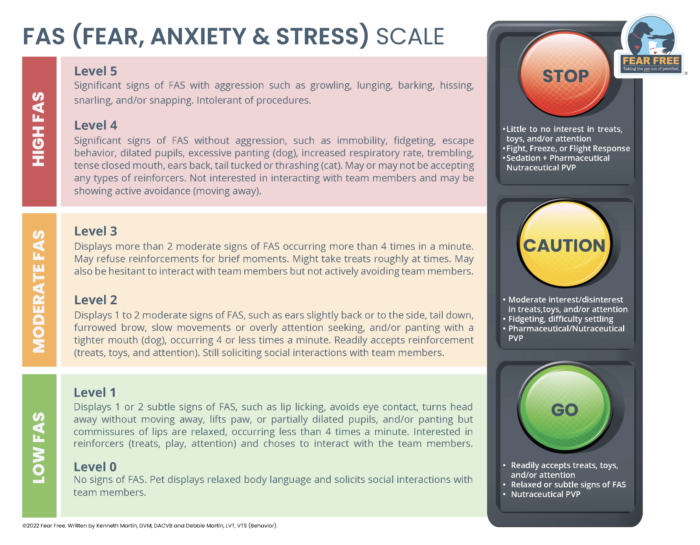In episode 58 of the Paws & Reward Podcast, I chat about the Fear Free Movement with Tabitha Kucera, a registered veterinary technician and certified positive reinforcement behavior consultant. We discuss why keeping data about our pet’s emotional experience is so important for their well-being and how we can do it accurately. Watch our conversation on my YouTube Channel.
What is the Fear Free Movement?
The Fear Free movement is the concept of practicing veterinary medicine that involves the reduction of stress in our patients which in return will result in a better experience for all involved — including pets, owners, and the veterinary team. It’s about prioritizing the emotional well-being of the animal. The movement is making sure to balance both the physical and mental health needs of the animal being treated.
What are the FAS scales and why were they created?
FAS is an acronym for fear, anxiety, and stress.
These scales were created to help give us more accurate and detailed information about the animals in our care. The scales show a comprehensive list of observable behaviors, ranging from low-stress to high-stress responses. The scales are used as a tool to communicate how the animal is feeling at any point during the physical exam. That way everyone is on the same page and can make adjustments to minimize the animal’s fear and stress. It can help us notice pain or behavioral changes more clearly.

Why would we want pet parents to track behavioral data?
Tracking data can give us an impartial and clear view of our pet’s behavior and what impacts their stress levels. With that data, we can provide our vets with better information. They’ll be able to see the full picture and any patterns we observe during our day-to-day life with our animals.
Fear and stress can be consequences of pain. Many of us dismiss our animal’s behavior changes as them getting older or being grumpy, but it can be an indicator of pain. Tracking our pet’s behavior using the FAS scale-or something similar- can help us see these changes in an objective way.

How can they track it?
Here is a list of ways you can keep track of your pet’s behavior.
- Videos – showing your pet walking, eating, and/or playing in their normal environments can help establish a baseline for your vet
- Diary – Simple checklist for certain physical or emotional behaviors, especially important for animals with chronic medical issues
- Using the FAS scale at home – including a quick one-page assessment
- Documenting pain signs before and after meds
Humans also experience FAS, how might tracking our own behavioral data be beneficial?
Humans and animals learn similarly. Learning about animal behavior can help us understand our own behavior, too. It’s easy for us to dismiss our own signs of stress, anxiety, and burnout. Being aware of these changes can show us when we need to reach out to others for help or speak to our doctor.
Tracking our mood, stress triggers, and anxiety spikes can help give our doctors valuable information for possible diagnosis. It’s easy to self-diagnose and panic. When we start keeping clear data we can see patterns and complete the puzzle in an objective way.
We often create a narrative for ourselves that can be untrue, but keeping data will help clarify that narrative and give us the tools we need to better advocate for ourselves.

